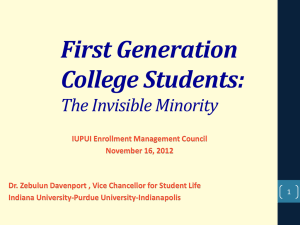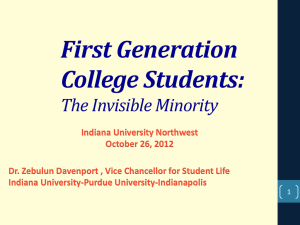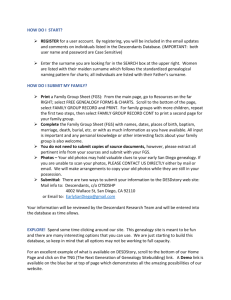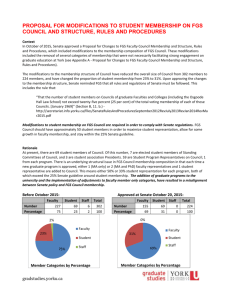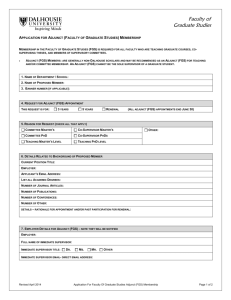Cycle 7 FGS Calibration Plan
advertisement
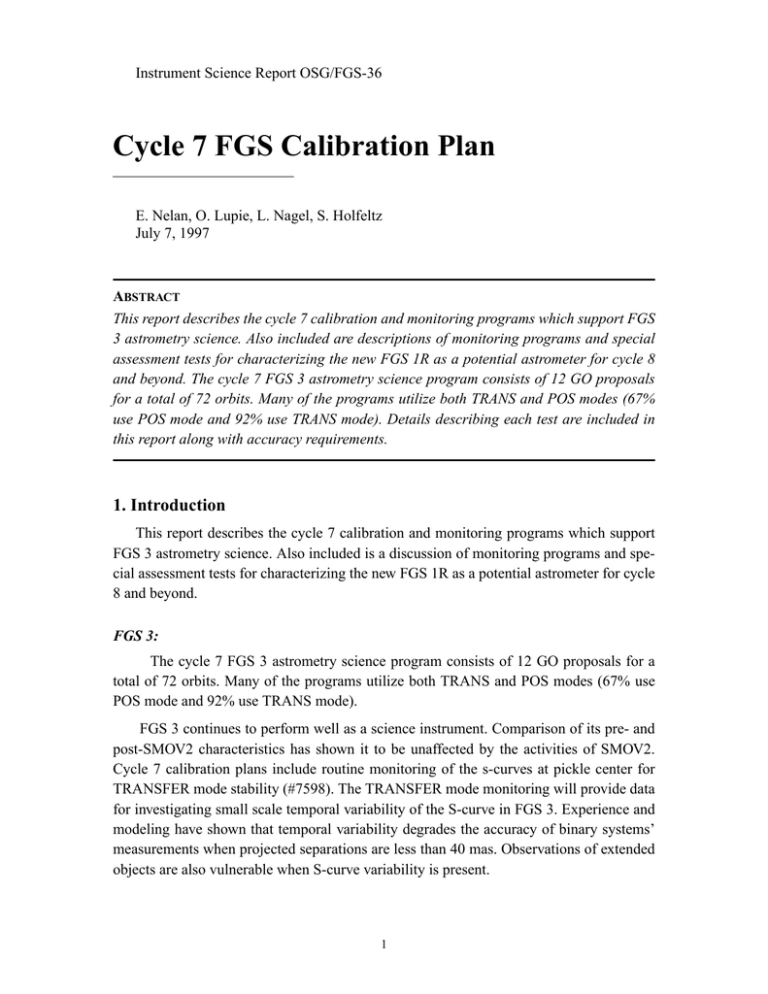
Instrument Science Report OSG/FGS-36 Cycle 7 FGS Calibration Plan E. Nelan, O. Lupie, L. Nagel, S. Holfeltz July 7, 1997 ABSTRACT This report describes the cycle 7 calibration and monitoring programs which support FGS 3 astrometry science. Also included are descriptions of monitoring programs and special assessment tests for characterizing the new FGS 1R as a potential astrometer for cycle 8 and beyond. The cycle 7 FGS 3 astrometry science program consists of 12 GO proposals for a total of 72 orbits. Many of the programs utilize both TRANS and POS modes (67% use POS mode and 92% use TRANS mode). Details describing each test are included in this report along with accuracy requirements. 1. Introduction This report describes the cycle 7 calibration and monitoring programs which support FGS 3 astrometry science. Also included is a discussion of monitoring programs and special assessment tests for characterizing the new FGS 1R as a potential astrometer for cycle 8 and beyond. FGS 3: The cycle 7 FGS 3 astrometry science program consists of 12 GO proposals for a total of 72 orbits. Many of the programs utilize both TRANS and POS modes (67% use POS mode and 92% use TRANS mode). FGS 3 continues to perform well as a science instrument. Comparison of its pre- and post-SMOV2 characteristics has shown it to be unaffected by the activities of SMOV2. Cycle 7 calibration plans include routine monitoring of the s-curves at pickle center for TRANSFER mode stability (#7598). The TRANSFER mode monitoring will provide data for investigating small scale temporal variability of the S-curve in FGS 3. Experience and modeling have shown that temporal variability degrades the accuracy of binary systems’ measurements when projected separations are less than 40 mas. Observations of extended objects are also vulnerable when S-curve variability is present. 1 The Long Term Stability Monitor for FGS 3 POS mode (#7677) will continue in cycle 7. The LTSTAB monitors changes to the relative plate scale and maintains the OFAD calibration. These data are essential to meet the POS mode error budget of 2 mas. Without the calibrations derived from these data, the errors swell to many tens of mas. Also in support of POSITION mode science data, the plate scale of the central region of the pickle will be measured by observations of several Hipparcos stars (#7679). This is a fundamental astrometric calibration which provides a plate scale accurate to 0.5 mas/arcminute. Finally, some cross-calibration measurements which relate POS mode observations in different filters and POS and TRANS mode observations will be obtained (included as part of the color calibration proposals). As before in previous calibration cycles, TRANSFER mode observations will be made of single stars of various colors (#7681 and 7682) to be used as reference S-curves in the analysis of GO science data. An expanded color library will help us to derive semiempirical models of the S-curve as a function of color. Because of the paucity of calibration hours, the color calibration stars have been selected according to the color needs of the GO. Experience with the S-curve analysis (Otto Franz et al) has shown that reference S-curves within 0.2 to 0.3 color magnitudes of the target will not introduce unacceptable systematic errors. New to cycle 7 calibrations is the quantification of an effect whereby the measured separation of the components of a binary system is seen to be slightly HST roll dependent (#7680). The test data will be used to verify and fine tune the HDOS model. The HDOS model will then become part of the FGS 3 astrometry pipeline. FGS 1R: On May 18, 1997 the newly inserted Fine Guidance Sensor (FGS 1R) was commissioned for routine operations. It has since served as a reliable instrument used for pointing and guiding the HST observatory. As part of the FGS 1R commissioning process, its optical performance was optimized by adjustment of the articulating fold-flat #3 mirror (FF3). Also, its position in the HST focal plane relative to the other FGSs and science apertures was determined, and its internal optical field angle distortion (OFAD) was measured (as was also done for FGS 2 and FGS 3). On-orbit testing of FGS 1R has demonstrated that its optical response is in fact field dependent with near perfect performance at pickle center, but degrades at the pickle's extreme azimuthal edges. Nevertheless, it is by almost any measure currently the best FGS onboard HST. With its near perfect optical performance at pickle center FGS 1R promises to be the best orbiting interferometer available for use as a science instrument. Simulations suggests that it will be able to resolve binary systems when the components are separated by angular distances as small as 6 milli-seconds of arc provided the magnitude differences are not larger than about 1.5 (this will be tested by on orbit measurements). By comparison FGS 2 3, the current HST astrometer, has difficultly along one of its interferometric axis when the separations are less than 20 mas. However, before FGS 1R can be commissioned as a science instrument it must be stable and calibrated. Early assessments have indicated that it is not yet sufficiently stable (due to outgassing) and therefore not ready for calibration. STScI will be monitoring this instrument in both POSITION and TRANSFER mode to determine when temporal stability has occurred. At such time calibrations can be initiated and FGS 1R can be commissioned as a science instrument. The cycle 7 monitoring program for FGS 1R includes stability monitors in both POS and TRANS modes (#7678 and 7597 respectively). In addition two assessment tests are included. The goal of the first test (#7684) is to determine the minimum angular separation of a binary system that can be interferometrically resolved. This result should clearly demonstrate FGS 1R’s enhanced performance relative to FGS 3. The second test (#7680) checks for the effect whereby the measured angular separation of a binary system is a slight function of HST roll. It will also serve as a baseline measurement for future trending. 3 Table 1: FGS Cycle 7 Calibration Plan Estimated Time (orbits) ID Proposal Title Frequency “External” 3 1R Products Accuracy Notes “Internal” Routine Monitoring Programs Long Term TRANS Mode Stability monthly 3x, FGS 1R 4/yr 0 7 0 ISR S/N ~ 100 variations detection at 2% Cal strategy 7598 Long Term TRANS Mode Stability monthly 3x, FGS 3 4/yr 7 0 0 ISR S/N ~ 100 variations detection at 2% Cal strategy 7677 FGS 3 Long Term Stability Monitor for POS Mode 3x 9 0 0 Pipeline, ISR 2.8mas/ pickle 0.7mas per obs, 2.0 in pickle center, 3.5 mas across pickle 7678 FGS 1R Long Term Stability Monitor for POS Mode 3x 0 6 0 Assessment 1-2mas per star detect 2 mas variations 4 7597 Special Calibration Programs 7679 FGS 3 Intermediate Plate scale 3x 3 0 0 Pipeline, ISR 0.5mas/ arc-min 7680 FGS 3 and FGS 1R TRANS Mode Plate Scale Calibration 7 5 2 0 Pipeline, ISR S/N~100 S/N, S-curve = 100, roll angles ~ 20 deg 7684 HST Astrometry Angular Resolution Test (FGS 1R & FGS 3) 1x 3 5 0 7681 FGS 3 RED Transfer Function Reference Calibration 1 6 0 0 Pipeline, ISR S/N~100 calibrate to 2% 7682 FGS 3 BLUE Transfer Function Reference Search and Calibration 1 5 0 0 Pipeline, ISR S/N~100 calibrate to 2% 38 20 0 TOTAL TIME (including all executions) S/N > 100 Accuracy goal: detection at 6 mas sep ISR for FGS 1R and 11 mas detection for Limiting FGS 3. capability, assessment Assumes 19 months in cycle 7 Proposal ID 7597: FGS Cycle 7: Long Term Stability of FGS 1R in TRANSfer Mode Plan Purpose: Measurements of stellar source Upgren 69 in FGS 3 have been obtained in TRANSfer mode from as early as 1990 through as recently as 1997_080. Variability of the modulation and morphology of the S-curve has been seen. The amount of change can have important consequences in the reduction of binary star science data when the separations are small (< 20 mas) and the magnitude difference is greater than about 0.6. It is expected that FGS 1R will also demonstrate temporal variability. The near ideal S-curves in FGS 1R are expected to resolve multi-star systems when the separations are as small as 5 to 10 mas. Temporal instabilities in the interferometer of the size seen in FGS 3 can have important consequences on the performance of FGS 1R. This proposal will establish a baseline for FGS 1R and will help determine its readiness to be used as a science instrument in TRANSfer mode. Description: Observe Upgren 69 with FGS 3 in TRANSfer mode once per month in early Cycle 7 and then every 4 months for the later 12 months of Cycle 7. Each visit will be one orbit. This schedule will provide information on variability at the short term and long term timescales. Fraction of GO/GTO Programs Supported: Assessment Resources: Observation: 7 external orbits, 1 orbit each month for 3 months then 1 orbit every 4 months. Special Requirements: Accuracy: S/N ratio for one visit’s co-added scans ~ 100. Relative changes between separate visits’ s-curves detectable to 2%. Products: ISR, calibration strategy. 5 Proposal ID 7598: FGS Cycle 7: Long Term Stability of FGS 3 in TRANSfer Mode Plan Purpose: Measurements of stellar source Upgren 69 in FGS 3 have been obtained in TRANSfer mode from as early as 1990 through as recently as 1997_080. Variability of the modulation and morphology of the S-curve has been seen. The amount of change can have important consequences in the reduction of binary star science data when the separations are small (< 20 mas) and the magnitude difference is greater than about 0.6. The analysis of extended source observations is also impacted. Therefore, this temporal instability must be characterized and monitored so that the library of calibration reference S-curves can be assigned a temporal adjustment when used to calibrate science data. Description: Observe Upgren 69 with FGS 3 in TRANSfer mode once per month in early Cycle 7 and then every 4 months for the later 12 months of Cycle 7. Each visit will be one orbit. This schedule will provide information on variability at the short term and long term timescales. Fraction of GO/GTO Programs Supported: 83% Resources: Observation: 7 external orbits, 1 orbit each month for 3 months then 1 orbit (of 4 orbits) every 4 months. Special Requirements: Accuracy: S/N ratio for one visit’s co-added scans ~ 100. Relative changes between separate visits’ s-curves detectable to 2%. Products: ISR, calibration strategy. 6 Proposal ID 7684: FGS Cycle 7: HST Astrometry Angular Resolution Test Plan Purpose: To determine and compare the angular resolution of FGS 1R and FGS 3 in TRANSfer mode. Performance of the x-axis interferometer in FGS 3 will be compared to that in FGS 1R. FGS 3 x-axis is degraded relative to the y-axis and is therefore the limiting component of FGS 3. A 9th magnitude known binary system whose components are separated by 0.352" and differ in magnitude by 0.6 will be used in this test. The position angle of the binary system will be aligned with the y-axis of the FGS so that small angular separations of the components projected long the x-axis can be varied in a known way by performing small HST/ FGS body rolls. The table below lists the proposed roll offsets and the expected angular separation (in milli-arcsec) of the stars along the x-axis. Description: TRANS mode observations of a known binary will be obtained at various roll angles in FGS 1R and FGS 3. POS mode observations of the binary and one reference star will be obtained to establish the roll of the telescope. An additional two orbits, one for FGS 3 and FGS 1R, will be acquired at the same time to obtain single star transfer scan data which provides the reference S-curves needed in the data reduction. This reference star will have the same B-V color index. As a side note, the reference star measurement in FGS 3 will most likely save an orbit in the full cycle 7 FGS 3 calibration program. The two roll positions to be measured in FGS 3 will provide comparative data with regards to its ability to detect the binary (at 11 mas separation) and its reliability to measure the separation (error bar) at 25 mas. The separations chosen for FGS 1R will determine its detection limits and the precision of its measurements as a function of separation. Table 2: Binary Observations designated by Axis Projection FGS 1R Offset Angle X sep visit 3 -1.0 6.0 visit 4 -1.8 11.0 visit 5 -2.7 16.0 visit 6 -4.1 25.0 FGS 3 visit 7 visit 8 Fraction of GO/GTO Programs Supported: Assessment Resources: Observation: Binary: 4 orbits in FGS 1R and 2 orbits in FGS 3. Calibration: 2 orbits 7 (1 per FGS) Special Requirements: Specific orientation requested. Accuracy: Goal: detection in FGS 3 at 6 mas, in FGS 1R at 2 mas. Required S/N ~ 100. Products: ISR, assessment of limiting capabilities. Minimum-plan Implications: Drop FGS 3 companion orbits. 8 Proposal ID 7677: FGS Cycle 7: FGS 3 Long Term Stability Monitor for POS Mode Plan Purpose: To monitor the temporal changes of the relative plate scale and OFAD of FGS 3. Relative plate scale and geometric distortions vary with time. The data obtained in the 1995-1995 season revealed changes in the relative plate scale on the order of many tens of mas. The LTSTAB results are incorporated into the OFAD/plate scale calibration in the POS mode pipeline. The instability is successfully removed and POS mode calibration is maintained at the 2 mas level. Description: F583W POS mode observations of an astrometric field in M35. The last year of monitoring has shown that bi-monthly monitoring will adequately address the variability. Fraction of GO/GTO Programs Supported: 67% Resources: Observation: 9 orbits, 3 per M35 observing season (3 seasons in cycle). Special Requirements: Accuracy: Observational accuracy is 0.7 mas per star; 1.3 mas rss per observation set (plate). This maintains accuracy of the POS mode calibrations to 2 mas rss in the central region of the pickle, 3.5 mas for the entire pickle. Products: Adjustments to the OFAD parameters used in the POS mode pipeline. Minimum-plan Implications: Reducing the monitoring to 2 per M35 season would make the calibration vulnerable to anomalous, abrupt changes. Variations have been seen to occur over 2-3 month timescales. 9 Proposal ID 7678: FGS Cycle 7: FGS 1R Long Term Stability Monitor for POS Mode Plan Purpose: SMOV results have shown that FGS 1R S-curve morphology and modulation will greatly enhance astrometric performance of the HST. With this promising expectation comes the requirement of instrument stability. This test provides the minimum number of observations needed to check for instabilities which might preclude any cycle 8 pursuit of astrometric commissioning. Description: F583W POS mode observations of an astrometric field in M35. Fraction of GO/GTO Programs Supported: Assessment test Resources: Observation: 6 orbits: 2 orbits 1997 Fall, 2 orbits 1998 spring, 2 orbits 1998 Fall Special Requirements: Accuracy: This test is designed to reveal relative variations at the 2-3 mas level. Products: Trend analysis to establish FGS 1R stability and repeatability. Minimum-plan Implications: This is the minimum plan. Since an astrometric science quality OFAD calibration is not available for FGS 1R, two observations of the M35 field are needed at each of the two HST orientations used in this test. 10 Proposal ID 7679: FGS Cycle 7: FGS 3 Intermediate Plate scale Plan Purpose: To provide a fundamental absolute scale measurement in FGS 3. The OFAD calibration is insensitive to scale while the LTSTAB proposal monitors the relative scale. This test measures the absolute scale to 0.5 mas/arcminute in the central region of the pickle. Monitoring the absolute plate scale is needed for the final determination of proper motion and parallax observations. Description: F583W POS mode observations of Hipparcos standard field. The central portions of the pickle will be mapped. Fraction of GO/GTO Programs Supported: 70% Resources: Observation: 3 orbits over 19 months to monitor the absolute FGS 3 plate scale in the central regions of the pickle. Special Requirements: Accuracy: 0.5mas/arc-min Minimum-plan Implications: This is the minimum plan. Visits 1 and 3 are at the same HST orientation and pointing. This eliminates contamination by the OFAD residuals on the plate scale measurements. Visit 2 is oriented 180 degrees from visits 1 and 3, and therefore provides an assessment of the OFAD calibration errors on the plate scale measurement. 11 Proposal ID 7680: FGS Cycle 7:FGS 3 and FGS 1R TRANS Mode Plate Scale Calibration Plan Purpose: Several GO programs have revealed an effect where the measured separation of the components of a binary system is sensitive to its orientation relative to the FGS interferometer axis, i.e. HST roll. The impact of this effect is to introduce systematic variations to the binary’s orbit which appear as perturbations by massive dark companions. HDOS has developed a model and this data will be used to verify the model and determine the relevant parameters. Description: FGS 3: Obtain TRANSfer scan data of a known binary a 5 different roll angles (20 deg apart) to calibrate the effect. FGS 1R: Obtain TRANSfer scan data of the same binary at 2 roll angles. These data will allow us to detect the effect if it is present in FGS 1R and provides a baseline. Fraction of GO/GTO Programs Supported: 80% Resources: Observation: 1 target at 5 orientations in FGS 3 and 2 orientations in FGS 1R Special Requirements: Accuracy: S-curve accuracy is defined here as the ratio of peak-to-peak signal to the Poisson noise in the fringe. A S/N in the co-added S-curve ~ 100 is needed to define specific instrumental features in the modulation and morphology. Minimum-plan Implications: This represents the minimum plan for the FGS 3 portion. FGS 1R may be postponed until cycle 8 however the results of this assessment are really crucial in defining TRANS mode accuracy limits and in establishing a baseline. 12 Proposal ID 7681: FGS 3 RED Transfer Function Reference Calibration Plan Purpose: This proposal acquires Transfer Scan Color calibrations. The FGS Transfer Function is wavelength dependent. However models and extrapolations have yet to successfully reproduce, to acceptable accuracies, the color dependence. One reason is that the data base of reference transfer functions is very limited. In addition temporal instability of the S-curve itself exists but time scales and even characteristics of that variability have not been established at this point and could be of the same order as the color dependence. We recommend that the color reference scan must be obtained in the same epoch of the GO observation (and possibly much more frequently). Semi-empirical modeling has shown that when delta (B-V) exceeds 0.2-0.3 magnitudes, the residuals of the deconvolution significantly degrade the reliability of the results of the binary star analysis. To deconvolve a binary or multiple system, reference Transfer scans of a non-binary of appropriate color and scaled by relative brightness are required to solve the system. This proposal requests Transfer Scan measurements on single stars in the color range (and filter) of the GO targets in cycle 7 (see table). Description: Obtain TRANS mode scans on the non-binary standard stars in the relevant color/filter combination. The standards are chosen such that their colors are within 0.2-0.3 magnitudes of the target stars. Table 3: Reference Red Colors Needed by Cycle 7 GOs Filter PUPIL & F583W F5ND B-V # Orbits 0.7-0.9 1 1.4-1.6 1 1.7-1.9 1 2.0-2.2 1 1.2-1.4 1 1.6-1.8 1 Fraction of GO/GTO Programs Supported: 83% Resources: Observation: 6 orbits total; 1 orbit per target/filter combination. Special Requirements: Accuracy: S-curve accuracy is defined here as the ratio of peak-to-peak signal to the Poisson noise in the fringe. A S/N in the co-added S-curve ~100 is needed to define specific instrumental features in the modulation and morphology. 13 Products: Catalog of reduced red transfer scan calibrations for use in either the STAT or the STScI pipeline. This catalog will be stored in CDBS, the GO reference directory and documented in an ISR. Minimum-plan Implications: A single reference Transfer function within 0.2-0.3 magnitudes will limit the "color" error to a few percent. As an example, simulations using an imperfect reference TRANSfer scan show that detection and measurement limits are significantly affected (detection limit drop from 10 to 20 mas for a binary whose deltaM = 0.5). 14 Proposal ID 7682: FGS Cycle 7: FGS 3 BLUE Transfer Function Reference Search and Calibration Plan Purpose: This proposal acquires Transfer Scan color calibrations. The FGS Transfer Function is wavelength dependent. However models and extrapolations have yet to successfully reproduce, to acceptable accuracies, the color dependence. One reason is that the data base of reference transfer functions is very limited. In addition temporal instability of the S-curve itself exists but time scales and characteristics of that variability have not been clearly established and could be of the same order as the color dependence. We recommend that the color reference scan be obtained in the same epoch of the GO observation (and possibly much more frequently). Semi-empirical modeling has shown that when delta (B-V) exceeds 0.2-0.3 magnitudes, the residuals of the deconvolution significantly degrade the reliability of the results of the binary star analysis. To de convolve a binary or multiple system, reference Transfer scans of a non-binary of appropriate color and scaled by relative brightness are required to solve the system. This proposal requests Transfer Scan measurements on single stars in the color range (and filter) of the GO targets in cycle 7 (see table). In addition, we request 4 orbits to search for one blue non-binary star. All cycle 6 potential reference candidates were revealed as close (an unacceptable) binary systems. As soon as an appropriate candidate is found, no additional data will be needed for the calibration in this cycle. Description: Obtain TRANS mode scans on the non-binary standard stars in the relevant color/filter combination. The standards are chosen such that their colors are within 0.2-0.3 magnitudes of the target stars. Table 4: Reference Blue Colors Needed by Cycle 7 GOs Filter F5ND B-V 0.0 to - 0.3 <SEARCH CANDIDATES> # Orbits 1 4 Fraction of GO/GTO Programs Supported: 10% GO and reference library Resources: Observation: 1 orbits calibration, 4 orbits to find target. (if targets determined early, can drop some "search for" orbits). Special Requirements: Accuracy: S-curve accuracy is defined here as the ratio of the peak-to-peak signal to the Poisson noise in the fringe. A S/N in the co-added S-curve ~100 is needed to define specific instrumental features in the modulation and morphology. 15 Minimum-plan Implications: A single reference Transfer Function standard star whose color is within 0.3 magnitudes will limit the "color" error-dependent systematic effects to a few percent. 16

